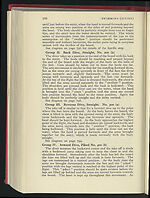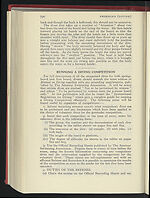1959-60
(863)
Download files
Complete book:
Individual page:
Thumbnail gallery: Grid view | List view

SWIMMING (DIVING)
789
the body straightens out the arms are brought beyond the head,
which is moved forward ready for the entry. The body must enter
the water straight and vertical with the back to the board.
See diagram on page Boo.
Group
V.
Forward Dive, Half-Twist, Straight, No. 5zo (a)
The take-off is exactly similar to that for the Forward Dive
Straight. At the highest point of the flight the left arm is lowered,
the right arm and shoulder pressed back and the head turned to
look along the left arm. As the body begins to turn the left arm is
pointed towards the point of entry. As the half-turn is completed
the head returns to " face front " and is dropped back, the arms
are moved beyond the head to the entry position. As the diver
sees the water the head is moved forward between the arms and
the body should then be straight for a vertical entry into the water.
The back should now be towards the board as in a backward dive.
Though the turn to the left has been described it is quite per-
missible to turn either to the right or the left in making this dive.
See diagram on page 8oi.
HIGH BOARD DIVING
As the diver does not receive any assistance from the board in
attaining height from the take-off, the main differences between
firm board and spring board diving may be summarised as follows:
(a) The take-off should be upward but a little more outward
than is the case from a spring board.
(b) In running dives the " run " must be smooth and confident
but it must be a decided run.
(c) In running dives the take-off may be from one or from both
feet.
The movements in the air and the entry into the water are similar
to those for dives from a spring board.
The beginner is therefore advised to learn his dives from a spring
board first, he has then only to master the technique of the take-off
from the firm board. It will be noted that in diving from either
type of board the top of the flight is reached before the movements
for the particular dive are commenced.
The Groups of Dives in the International Tariff for High
Board Diving. (Table B)
The dives which may be performed from firm boards have been
divided into six groups:
Groups I to V consist of the same types of dives as for Groups
I to V in the Spring Board Table.
Group VI consists of Armstand Dives.
Description of typical dives from Groups I, II, III, IV and
V have been given under the notes on Spring Board Diving.
Group VI. Armstand Dive, Straight, No. 600 (a)
Before attempting any of the dives of this Group the diver must
master the handstand. The balance on the board must be steady,
the arms should be straight and vertical and the legs should be
together with the toes pointed. The head should be held well
789
the body straightens out the arms are brought beyond the head,
which is moved forward ready for the entry. The body must enter
the water straight and vertical with the back to the board.
See diagram on page Boo.
Group
V.
Forward Dive, Half-Twist, Straight, No. 5zo (a)
The take-off is exactly similar to that for the Forward Dive
Straight. At the highest point of the flight the left arm is lowered,
the right arm and shoulder pressed back and the head turned to
look along the left arm. As the body begins to turn the left arm is
pointed towards the point of entry. As the half-turn is completed
the head returns to " face front " and is dropped back, the arms
are moved beyond the head to the entry position. As the diver
sees the water the head is moved forward between the arms and
the body should then be straight for a vertical entry into the water.
The back should now be towards the board as in a backward dive.
Though the turn to the left has been described it is quite per-
missible to turn either to the right or the left in making this dive.
See diagram on page 8oi.
HIGH BOARD DIVING
As the diver does not receive any assistance from the board in
attaining height from the take-off, the main differences between
firm board and spring board diving may be summarised as follows:
(a) The take-off should be upward but a little more outward
than is the case from a spring board.
(b) In running dives the " run " must be smooth and confident
but it must be a decided run.
(c) In running dives the take-off may be from one or from both
feet.
The movements in the air and the entry into the water are similar
to those for dives from a spring board.
The beginner is therefore advised to learn his dives from a spring
board first, he has then only to master the technique of the take-off
from the firm board. It will be noted that in diving from either
type of board the top of the flight is reached before the movements
for the particular dive are commenced.
The Groups of Dives in the International Tariff for High
Board Diving. (Table B)
The dives which may be performed from firm boards have been
divided into six groups:
Groups I to V consist of the same types of dives as for Groups
I to V in the Spring Board Table.
Group VI consists of Armstand Dives.
Description of typical dives from Groups I, II, III, IV and
V have been given under the notes on Spring Board Diving.
Group VI. Armstand Dive, Straight, No. 600 (a)
Before attempting any of the dives of this Group the diver must
master the handstand. The balance on the board must be steady,
the arms should be straight and vertical and the legs should be
together with the toes pointed. The head should be held well
Set display mode to:
![]() Universal Viewer |
Universal Viewer | ![]() Mirador |
Large image | Transcription
Mirador |
Large image | Transcription
| Games and sports in the army > 1959-60 > (863) |
|---|
| Permanent URL | https://digital.nls.uk/248874257 |
|---|
| Description | 'Games and Sports in the Army' was an annual publication produced by the British War Office between the 1930s and 1960s. This included the Second World War. It outlines the rules and regulations for games and sports played by members of the armed forces. It features names and photographs of team members, and examples of contemporary advertising. |
|---|---|
| Shelfmark | GWB.52 |

